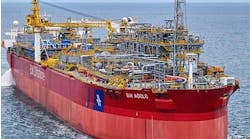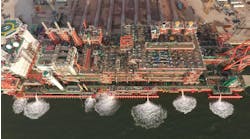MMS reviews annulus monitoring subsea
While the US Minerals Management Service is known as an ally of offshore E&P, the service is considering new regulation that could have a dramatic impact on the cost, design, and offshore installation of subsea trees. Currently MMS requires annulus monitoring on all surface trees. This means all the annuli between each casing string and the string hung off within it are regularly checked for increased pressure. The goal is to catch a pressure build up, caused by either formation leakage, a leak path between casing strings, or radical temperature change as a result of high-pressure, high-temperature (HP/HT) production. Such a build up, untended, could result in lost control event. In this design each of the annuli in the wellhead has its own valve so that if an increase in pressure were detected it is a simple matter to bleed off the pressure. Such designs are standard.
The regulations for subsea trees, on paper at least, are identical to surface trees. The difference is that subsea trees are almost routinely granted exemptions from this rule. The typical case made by the operators is that these systems are so over designed that such monitoring is not necessary. Beneath this agreement not to require monitoring of annuli on subsea trees is the additional design requirements such monitoring would require and the difficulty that would be encountered in regulating a pressure buildup if one were detected. For several years the situation has been one of cooperation, but this may be about to change. The MMS announced that, as of 2005, subsea trees would be required to meet the same criteria as surface trees. In affect this means an end to the common exceptions the industry has grown comfortable with.
While redesigning new subsea trees to comply with these regulations will no doubt be expensive and possibly cause delays, there are bigger questions to consider. On the one hand, the industry strives toward reliability in subsea systems. That is a driving force because any need for intervention severely damages the economic model driving such systems. The cornerstone of suck reliability is standardization. If the industry is required to redesign all of its subsea trees with additional valves and ports for monitoring, it is losing much of the hard learned lessons of previous, standard designs. At the same time, there are serious questions concerning the safety of HP/HT subsea developments. The fluids moving through these systems are hot enough to rapidly increase pressure in the casing annuli. This could be a situation where the risk of a new design is more than justified by the benefits of knowing what is going on below the seabed.
Regardless of the outcome, it is clear the MMS will work with the operators to develop a solution that will ensure the safety of this equipment without unduly impacting the economics of subsea completions.
INTEC Engineering acquires Fuel Subsea Engineering
Smit Land and Marine Engineering Ltd., a UK subsidiary of SMIT International, and INTEC Engineering (UK) Ltd. have completed an agreement allowing INTEC to acquire Fuel Subsea Engineering, headquartered in Woking, Surrey. Fuel has expertise in the development and implementation of diverless subsea connection systems, and general subsea engineering consul- tancy. INTEC Engineering provides engineering and project management services to the international oil and gas industry. The sale of fuel is part of a strategy by SMIT to withdraw from the oil and gas market.
The acquisition allows INTEC to accelerate its growth in the UK market where, after the combination, it has more than 80 staff working on several deepwater development projects. "Fuel's established market position and range of services complement INTEC's current activities and will further enable our combined organization to play a major role in the development of offshore oil and gas reserves by our clients," said Willem Timmermans, INTEC's President.
Peter Roberts, Managing Director of INTEC in the UK, explained that INTEC's UK engineering and project management operations will relocate to Woking and be combined with Fuel's. The combined organization will operate under the INTEC banner.
INTEC is a member of the Heerema Group involved in the engineering, offshore installation, fabrication, and heavy marine transport markets of the offshore oil and gas industry.
Tieback to Ursa increases hub production
Shell E&P's Crosby and Einset subsea fields are now online and sending production to their hub platforms. The three-well Crosby development is the first subsea tieback to Ursa. Crosby is located in Mississippi Canyon Blocks 898 and 899 of the Gulf of Mexico. Production from Crosby's first well began in December. Currently, all three wells are online and producing 20,000 b/d. Peak production for Crosby is expected to be approximately 60,000 b/d and 90 MMcf/d by the end of the first quarter of 2002.
Crosby is located about 160 miles southeast of New Orleans in approximately 4,400 ft water depth. Shell operates Crosby and has a 50% interest in the project; BP holds the remaining 50%. Using a dual flowline system, Crosby's production is carried from a six-slot manifold to Shell's Ursa tension leg platform. Ursa is located 10 miles from Crosby, on Mississippi Canyon Block 809 in 3,950 ft water depth. Once all of Crosby's wells reach peak production, Shell expects Ursa's total platform production to increase to 170,000 b/d. Crosby represents an expansion of SEPCo's development of the Mars Basin.
"Crosby is the first field to begin production in the southern part of the Mars Basin. Ursa, Mars, King, and ultimately, Princess, are all located in the northern part of the Basin," said Dave Lawrence, SEPCo Vice President, E&D.
Development costs for Crosby are approximately $298 million, excluding lease costs. Total gross ultimate recovery is estimated at more than 70 million BOE.
Concurrent with the Crosby startup, produc-tion from Einset began. Einset is currently producing at a rate of 30 MMcf/d. The Einset subsea development, also in the GOM, is located in 3,500 ft water depth. Einset is a single-well project located about 170 miles southeast of New Orleans in Viosca Knoll Block 872. Einset ties back to Shell's Southeast Tahoe manifold, which carries production 12 miles to Shell's Bud Lite platform.


